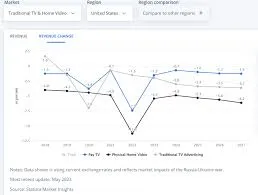Television has been a part of our daily lives for decades now, providing us with entertainment, news, and information. It has also been a major form of advertising, shaping our beliefs and influencing our buying decisions. With the advancements in technology and the rise of streaming services, the landscape of TV viewership has been constantly evolving. In this article, we will dive into the latest statistics and trends of TV viewership and how it has impacted the way we consume television.
Overview of TV Viewership

Television viewership is defined as the number of people who watch television programs at a given time. This statistic is important for broadcasters and advertisers as it determines the success of a show or an advertisement. Let’s take a look at some of the key statistics that paint a picture of the current TV viewership landscape.
TV Households
According to Nielsen’s National Television Household Universe Estimates, there are approximately 120.6 million TV households in the United States. This means that around 96% of American households have at least one television set. While this may seem like a high number, it has decreased from 99% in 2009. This can be attributed to the rise of streaming services and cord-cutting, which we will discuss later in this article.
Average Hours of TV Viewing
On average, Americans spend around 3 hours and 35 minutes watching TV every day. This has remained relatively consistent over the past few years, with a slight decrease from 2017 when it was 3 hours and 49 minutes. However, it is worth noting that the younger generation (18-34 year-olds) spends less time watching traditional TV and more time consuming digital media.
Top TV Networks
The top networks in terms of viewership in 2020 were Fox News, ESPN, MSNBC, and HGTV. These networks cater to different demographics and have been successful in attracting viewers through their diverse programming. However, with the rise of streaming services and the availability of content on multiple platforms, the competition for viewership has become tougher.
Factors Affecting TV Viewership
There are several factors that have contributed to the changing landscape of TV viewership. Let’s take a look at some of the key factors that have had a significant impact.
Rise of Streaming Services
Streaming services like Netflix, Hulu, and Amazon Prime have revolutionized the way we consume television content. With the ability to watch shows and movies on-demand, without any commercial interruptions, these services have gained immense popularity among viewers. In fact, according to Statista, the number of subscription video on demand (SVOD) users in the United States is expected to reach 198 million by 2025.
Cord-Cutting
Cord-cutting refers to the trend of canceling traditional cable or satellite TV subscriptions in favor of streaming services. This trend has gained momentum in recent years, with more and more people opting for streaming services as their primary source of entertainment. A survey conducted by eMarketer estimated that over 6.6 million households canceled their traditional TV subscriptions in 2020, and this number is expected to reach 9.2 million in 2021.
Technological Advancements
The advancements in technology have made it easier for viewers to access TV content on various devices, such as smartphones, tablets, and laptops. This has given viewers the flexibility to watch their favorite shows anytime and anywhere, which has impacted traditional TV viewership. Additionally, the rise of smart TVs has also contributed to the decline in traditional TV viewership, as viewers can now access streaming services directly on their TVs.
COVID-19 Pandemic
The COVID-19 pandemic has had a major impact on the TV viewership landscape. With people confined to their homes, there has been a significant increase in TV viewership. According to Nielsen, there was a 16% increase in overall TV viewership in March 2020 compared to the same period in 2019. This can be attributed to the rise in news consumption and the need for entertainment during lockdowns.
Demographics of TV Viewership

The demographics of TV viewership have also undergone significant changes in recent years. Let’s take a closer look at how different age groups consume television content.
Millennials (18-34 year-olds)
As mentioned earlier, millennials spend less time watching traditional TV and more time consuming digital media. In fact, according to Nielsen, in the third quarter of 2020, only 64% of millennials watched traditional TV, while 91% used some form of digital media. This trend is expected to continue as this generation grows older and becomes the dominant consumer demographic.
Generation Z (Ages 2-17)
Generation Z has grown up with technology and has a strong preference for digital media. A survey conducted by Common Sense Media found that this generation spends an average of 3 hours and 38 minutes on digital devices daily, compared to 2 hours and 39 minutes watching TV. This indicates a clear shift in the way younger generations consume media.
Baby Boomers (55-75 year-olds)
Baby boomers, on the other hand, still heavily rely on traditional TV for their entertainment needs. According to Statista, this demographic spent an average of 6 hours and 20 minutes watching TV every day in 2020. However, as this generation ages, it is expected that they will also adopt streaming services and other digital platforms for their TV consumption.
Impact on Advertising
TV advertising has been a major source of revenue for broadcasters for decades. However, with the changes in TV viewership patterns, advertisers have had to adapt their strategies to reach their target audience. Let’s take a closer look at how TV viewership has impacted advertising.
Decline in Traditional Advertising
With the rise of streaming services and cord-cutting, there has been a decline in traditional TV advertising. According to eMarketer, traditional TV ad spending is expected to decrease by 15% in 2021, while digital ad spending is expected to increase by 10%. This indicates a shift in advertising dollars towards digital platforms.
Addressable TV Advertising
Addressable TV advertising is a form of targeted advertising that allows advertisers to show different ads to different households watching the same program. This type of advertising has gained popularity in recent years as it allows for more targeted and efficient advertising. According to eMarketer, addressable TV ad spending is expected to reach $2.17 billion in 2021, a 25% increase from 2020.
Integration of Digital Platforms
To reach the younger demographic, advertisers have started to integrate digital platforms into their TV advertising strategies. For example, during live sporting events, advertisements may include hashtags or prompts to visit a website or social media platform. This allows for more engagement and interaction with the audience, especially with the rise of second-screen viewing.
Challenges and Opportunities

The changing landscape of TV viewership has presented both challenges and opportunities for broadcasters and advertisers. Let’s explore some of the key challenges and opportunities that have arisen due to these changes.
Challenge: Fragmented Audiences
With the rise of streaming services and other digital platforms, audiences are becoming increasingly fragmented. This makes it challenging for broadcasters and advertisers to reach a large number of viewers at once. Additionally, with the availability of on-demand content, viewers can now choose what they want to watch and when, making it difficult to predict viewership patterns.
Opportunity: Targeted Advertising
One of the biggest opportunities that have come with the changes in TV viewership is the ability to target specific audiences. With the integration of digital platforms and the availability of data, advertisers can now target their ads to a more relevant audience, resulting in a higher return on investment.
Challenge: Ad Blocking
As viewers become more tech-savvy, ad blocking has become a major challenge for advertisers. With the rise of streaming services and digital platforms, viewers can easily skip or block advertisements, making it difficult for advertisers to reach their target audience through traditional means.
Opportunity: Native Advertising
Native advertising is a form of advertising that matches the style and format of the content being consumed by the viewer. This type of advertising is less intrusive and more engaging, making it less likely to be blocked by viewers. This presents an opportunity for advertisers to reach their target audience effectively.
Future Trends

The TV viewership landscape is constantly evolving, and it’s important to stay up-to-date with the latest trends and predictions. Let’s take a look at some of the future trends that are expected to shape the industry.
Continued Rise of Streaming Services
It’s safe to say that streaming services are here to stay. With the convenience and flexibility they offer, the popularity of these services is expected to continue to rise. In fact, according to a survey by Deloitte, 82% of Americans subscribe to at least one streaming service.
Growth of Connected TV (CTV)
Connected TV refers to devices that allow viewers to access internet-based video content on their TV screens. This includes devices such as smart TVs, gaming consoles, and streaming devices. The growth of CTV offers new opportunities for advertisers to reach their target audience through targeted and interactive advertising.
Increase in Programmatic Ad Buying
Programmatic ad buying refers to the automated process of buying and selling advertising space. With the rise of digital platforms and the availability of data, programmatic ad buying is expected to increase in the TV advertising landscape. This will allow for more targeted and efficient advertising.
Growth of Virtual and Augmented Reality
Virtual and augmented reality are becoming more mainstream, especially with the rise of gaming and interactive experiences. This presents an opportunity for broadcasters and advertisers to create immersive and engaging content for viewers. For example, live sports events could incorporate virtual reality experiences for viewers who cannot attend the event in person.
Conclusion
The TV viewership landscape has undergone significant changes in recent years, and it’s important for broadcasters and advertisers to adapt to these changes to stay relevant. With the rise of streaming services and the growth of digital platforms, the competition for viewership has become tougher. However, this also presents an opportunity for targeted and efficient advertising. As technology continues to advance, we can expect to see further changes in the way we consume television content.





